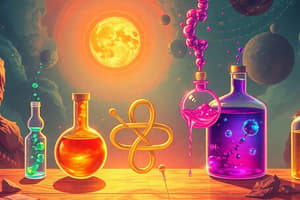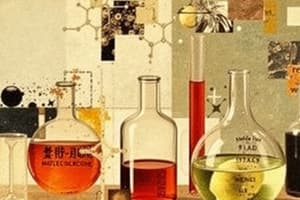Podcast
Questions and Answers
Which law describes the relationship that states the volume of a fixed quantity of gas at constant temperature is inversely proportional to the pressure?
Which law describes the relationship that states the volume of a fixed quantity of gas at constant temperature is inversely proportional to the pressure?
- Boyle's Law (correct)
- Charles' Law
- Avogadro's Law
- Dalton's Law
What is the empirical formula of a compound with the molecular formula C6H12O6?
What is the empirical formula of a compound with the molecular formula C6H12O6?
- CH2O (correct)
- C2H6O2
- C6H12O6
- C3H6O3
Which property of matter can be observed or measured without changing its chemical composition?
Which property of matter can be observed or measured without changing its chemical composition?
- Intrinsic property
- Chemical property
- Physical property (correct)
- Reactive property
When balancing a chemical equation, what is used to ensure the equation is balanced?
When balancing a chemical equation, what is used to ensure the equation is balanced?
What is the common name for the chemical compound represented by the formula C3H6O3?
What is the common name for the chemical compound represented by the formula C3H6O3?
What is the relationship between the number of moles of gas and its volume at constant temperature and pressure according to Avogadro's principle?
What is the relationship between the number of moles of gas and its volume at constant temperature and pressure according to Avogadro's principle?
Which of the following rays is NOT produced by radioactive isotopes?
Which of the following rays is NOT produced by radioactive isotopes?
What describes the ratio of the actual yield to the theoretical yield in a chemical reaction?
What describes the ratio of the actual yield to the theoretical yield in a chemical reaction?
Flashcards
Dalton's Law of Partial Pressures
Dalton's Law of Partial Pressures
States that volume and temperature are the same for each gas in a container.
Limiting Reactant
Limiting Reactant
The reactant that is completely consumed in a reaction, limiting the amount of product formed.
Stoichiometry
Stoichiometry
The study of the amounts of materials consumed and produced in chemical reactions.
Physical Property
Physical Property
Signup and view all the flashcards
Distillation
Distillation
Signup and view all the flashcards
Percent Yield
Percent Yield
Signup and view all the flashcards
Boyle's Law
Boyle's Law
Signup and view all the flashcards
Mole Fraction
Mole Fraction
Signup and view all the flashcards
Study Notes
Chemical Concepts
- Dalton's Law of Partial Pressures: Applies to gases in a container, individual gas pressures sum to total pressure.
- Molecular Formula of Lactic Acid: C3H6O3
- Stoichiometry: Calculation of reactants and products involved in chemical reactions. (e.g., Moles of N2 for 42 g and 51.1 grams of product formation).
- Limiting Reactant: In a reaction, the reactant that is consumed first, limiting how much product can be formed (ex: NaCl in the example given).
- Stoichiometry calculation of grams of CO2 formed when ethylene is combusted, and grams of NH3 is produced in a reaction.
- Physical Properties: Properties that can be observed without changing the composition of a substance (ex: density, boiling point).
- Distillation: Process for separating the components of a liquid mixture based on boiling points
- Isotopes: Atoms of the same element with different numbers of neutrons (e.g., Alpha, Beta, Gamma are types of radioactive isotopes).
- Empirical Formula: Simplest whole-number ratio of atoms in a compound (e.g., simplest ratio of atoms in a molecule).
- Balancing Chemical Equations: Making the number of atoms of each element the same on both sides of the reaction using coefficients.
- Percent Yield: Ratio of actual yield to theoretical yield.
- Mole Fraction: Ratio of the moles of a specific gas to the total moles of gas in a mixture.
- Glucose: Chemical compound (C6H12O6)
- Nitrous Oxide: Chemical compound (N2O)
- Pressure: Force applied per unit area (e.g., Pressure in a semi-deflated balloon).
- Boyle's Law: At constant temperature, the volume of a given mass of gas is inversely proportional to its pressure.
- Charles' Law: At constant pressure, the volume of a given mass of gas is directly proportional to its absolute temperature.
- Avogadro's Law: At the same temperature and pressure, equal volumes of different gases contain the same number of molecules.
Additional Notes
- Chemical formulas represent the ratio of elements and compounds in a chemical substance.
- Balancing equations is used to make sure that the same number of atoms of each type are on both sides of the reaction arrow.
- The correct mathematical notation, in case there are coefficients for balancing equations or in ratios, is used.
Studying That Suits You
Use AI to generate personalized quizzes and flashcards to suit your learning preferences.




